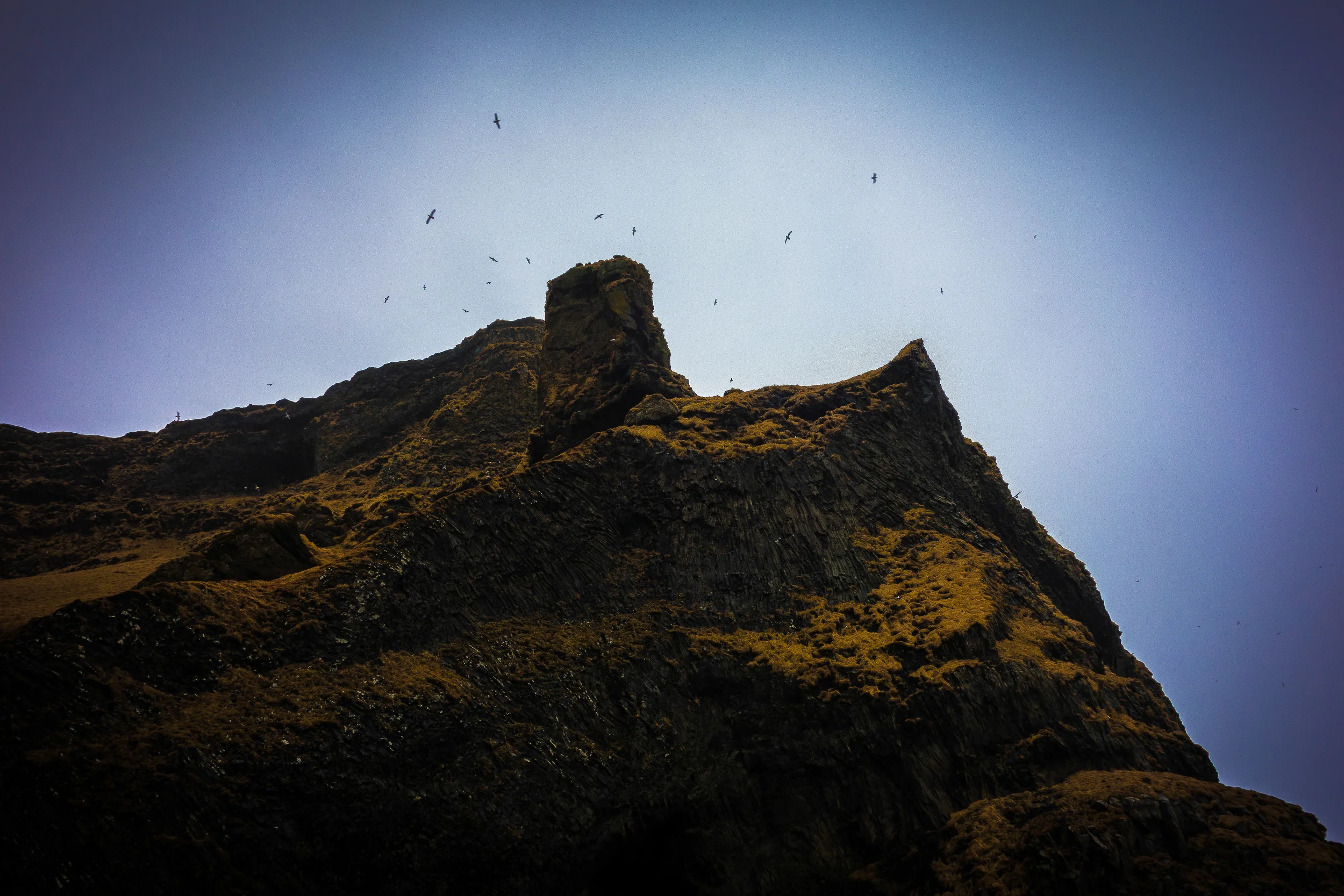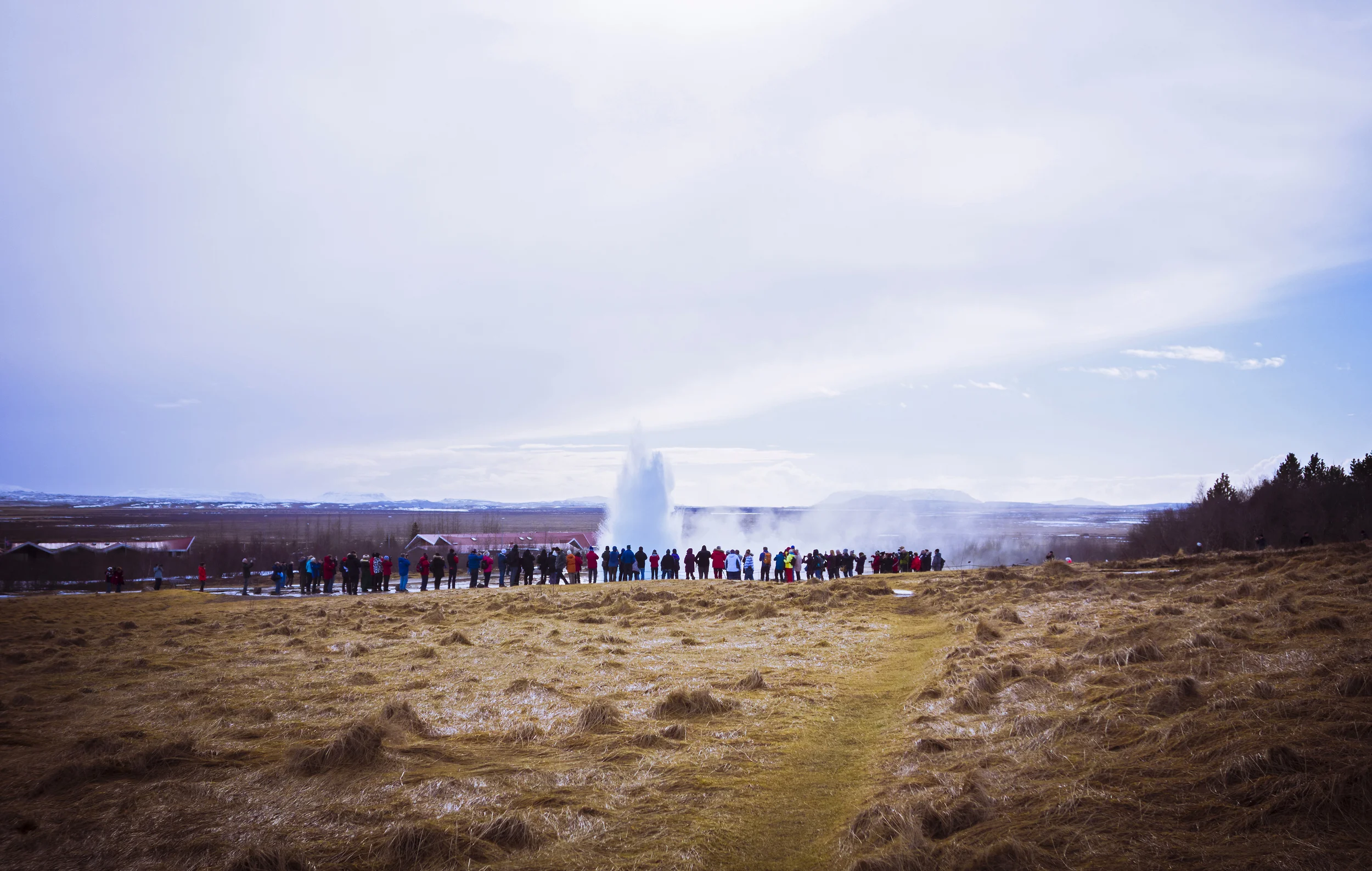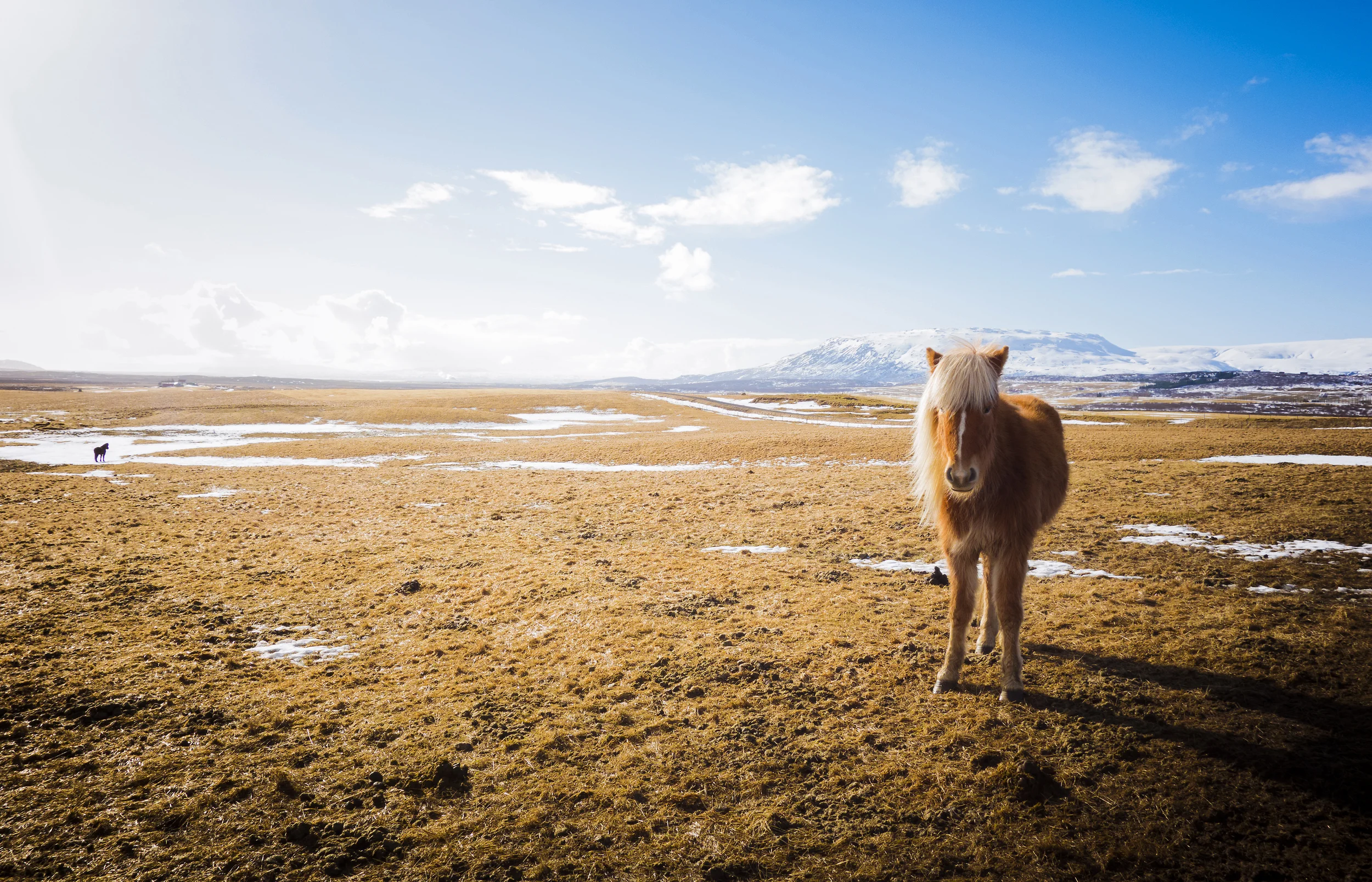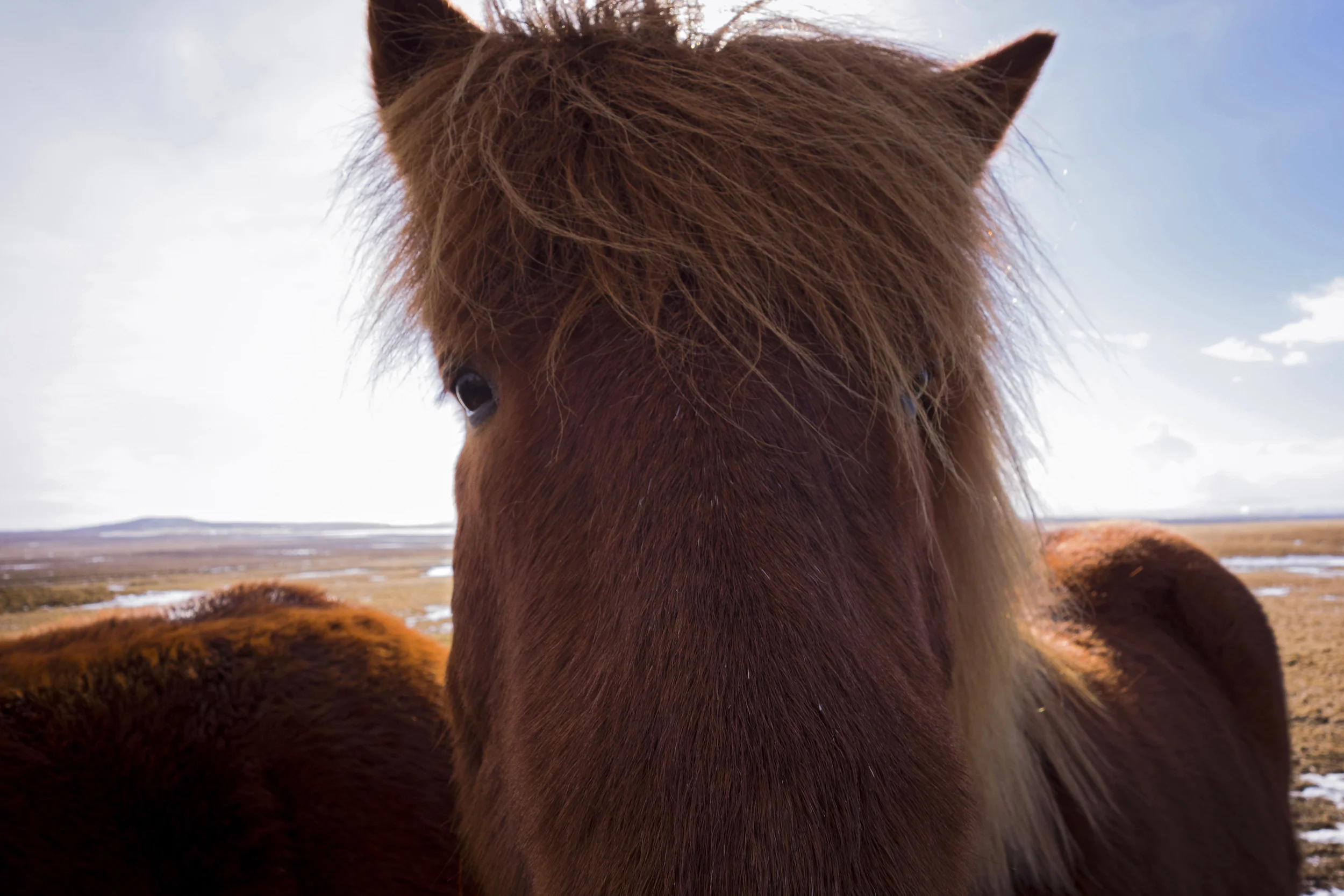It is shortly past 6 AM when we land in Keflavík, an industrial fishing town and former U.S. military base on the Reykjanes Peninsula, in the southwest of Iceland. The sky outside is shrouded, and the runway lights glow in the wavering dark of the early morning. Despite my window seat, I got very little sleep on the five-hour flight across the Atlantic; I think anticipation has kept me awake. I look back a row at Jane, who swapped seats to allow a pair of honeymooners to be together; she has not slept much either.
Keflavík International Airport is bright and geometric, though not in an oppressive way. Perhaps it is because we are the first arrivals of the morning, and the terminal is largely an empty expanse of angular furniture and well-lit kiosks. I am reminded (not unpleasantly) of power-walking through Ikea with Jane, both of us fully aware of the game plan: yes $5 Swedish meatballs; no $10 post-modern, monochrome, self-assembled home furnishings. In the airport convenience store, we pick up a pair of sandwiches, bottles of juice, snack chips, and two cups of a mysterious substance called skyr. According to my extensive pre-departure research, a consensus panel of experts (i.e. the first few results in Google) has concluded, through rigorous and scholarly analysis, that skyr is "Greek yogurt, except it doesn't taste, smell, and feel like a fart." We shall see. We grab our rental car keys and head out.
In the airport parking lot, daylight is beginning to creep over the landscape; everything is coated in a pale blue. This amplifies the coolness of the sharp, northerly wind; I stare at the patches of snow and ice on the pavement, and in my head I quickly re-calculate every detail of this five-day, 800-mile mid-March road trip in Iceland, resulting in this totally reasonable, actionable thought: "Oh. Hmm..." There is some fudging around as we reach our car, a hatchback Volkswagen Golf, and, never having rented a car together before (!), we examine it like a pair of touristic aliens from a distant planet. The first dozen photos on my camera are totally non-contextualized macro shots of the side of the car ("Is that a dent? Is that a dent? That's a tiny scratch. Yes it is. Jon, what about this little smudge thing?"). Inside the car, more fudging around; we set up our GPS and discover it is mighty difficult to spell "Seljalandsfoss", let alone the name of whatever town/highway/road it is located nearest to. Fortunately, in a fit of inspiration two nights ago, I wrote down latitude/longitude coordinates for every parking turnoff on our trip. Estimated driving time to Seljalandsfoss is two hours, and Jane will be hearing me brag about my coordinates the entire time.
We set off on the highway that leads northeast toward Reykjavík, crossing the lava-covered peninsula which is one of the geologically freshest parts of the island. It is all very eerie; in the early morning light, a strange, bumpy green-and-black landscape extends from the roadside as far as the eye can see; the eye follows this out until it is caught off-guard by the distant mountains, fully two-thirds of their height coated in snow. "Iceland!" I exclaim. We return our concentration to the road: the landscape will be plenty more visible in an hour, and we are two young California drivers who need to master the roundabout.
Near the suburb-town of Hafnarfjordur (I find this amusing and lovingly repeat it multiple times at Jane), we turn off and begin our long journey east on the Ring Road (Highway 1), the major roadway that encircles the entirety of the island. We pass familiar yet utterly foreign blocks of suburb (Grocery stores! Gas stations! Ikea!) that are totally deserted on this early Sunday morning. As we leave town, the road begins to climb until we crest a plateau. Suddenly, everything is white. In the distance, massive plumes of white steam rise hundreds of feet over the land - signatures of Iceland's incredible geothermal power, smartly married to a national love for clean energy. The single lane highway stretches into the horizon, icy but with a clear track for our tires, and all around us is a massive flat plain of whiteness, punctuated by a white sheet of lake ice and a ridge of mountains seemingly composed entirely of elevated ice. Jane and I have both driven in snow: up in the mountains in California, where you knew you would be permanently done with it after so many more switchbacks; and in Maryland, where if less than an inch has fallen over three consecutive days, your city's entire cohort of drivers will calmly assemble into a several-hundred-car pileup necessitating intervention from the National Guard. But we have never driven in this kind of snow, across a landscape so utterly barren and devoid of heat that it reminds me just how close we actually are to the Arctic. "Iceland!" I exclaim again.
We soon descend the plateau, continuing eastward toward the town of Selfoss, and dropping below us is an expanse of yellow, flat farmland. To the right (south) of this land, I can see the Atlantic Ocean, dark grey waves pounding on dark grey sand; to the left (north), a ring of tall cliffs and mountains shields the interior of the island, like a mystical wall concealing some horrible, ancient secret. These were formerly sea cliffs, and the entire landscape before us was formerly underwater; mighty rivers transformed over eons into mightier waterfalls, and estuaries transformed, with volcanic aid, into enormous black flood plains that defy imagination. I marvel at the scope of the geology at work here - an entire island lifted out of North Atlantic by glacial melting and isostatic rebound. When we reach Selfoss, it is an utterly gray little town, still deserted (Iceland must take its weekends seriously, we conclude). There is construction on the main road through town, sans construction workers; the broken-up pavement, the gray mist from the nearby river, and the lifelessness of the entire place is haunting, evoking the ghost town of the Silent Hills series. We detour around the construction zone and proceed east along the coastal plain; the car radio plays a Celine Dion compilation.
We see Seljalandsfoss from over a mile away. More than most waterfalls, when you look at it, the river seems to truly flow off the cliff, forming a lovely arc that lands only reluctantly in the icy pool below. We pull into the parking lot and take in the scene with breakfast from the comfort of our car. I pop open my cup of strawberry skyr; Jane has vanilla. Verdict: skyr is absolutely delectable. It is a wondrously creamy, flavorful cross between yogurt and a protein bar. It has none of the fart sensation that accompanies Greek yogurt, the consumption of which, to me, is like eating concentrated vomit from a leathery udder. Jane and I had zipped open the wrapping on our sandwiches, in anticipation of needing a major breakfast - but a cup of skyr later, we feel satiated and strong. We don our outerwear; Jane debates between two equally silly hats before deciding to wear neither for the remainder of the trip.
We walk up to the falls; I am just learning how to shoot fully manually, and most of my photos are unsuccessful. We take a few long exposures at the base of the falls before climbing up an ice-covered slope and staircase beside the waterfall, slipping all the while. We are pelted by the spray - glacial water, augmented by melting winter ice from the highlands of one of the northernmost countries in the world. There is a path that leads directly behind the waterfall, such that you can stand beyond the curtain and get pelted even harder - but it is even more treacherous, and we decide not to push our sleep-deprived luck on this, the first stop of our trip. Up above us, the kittiwakes and gulls circle from their nests on the moss-covered cliffs; and to the northwest along the cliff, smaller cascades are visible less than a mile away. There is a sizeable crowd here, even in the shoulder season before complete thaw; we dodge a few tripods on our way back to the car (and quickly realize we are just a pace ahead of the tour buses; they arrive at 11 AM).
Jane takes a quick nap as I drive down the highway to our next waterfall - Skógafoss ("Forest Falls"), an enormous, 200-foot, rectangular cataract that plunges perpendicularly off what clearly used to be a sea cliff. I take a self-portrait (above) as Jane regains consciousness in the car. We climb the stair steps that lead to the top of the cliff. We clamber to the edge of the cliff to stare at this mighty wall of water head-on, watching the seabirds fly from one cliff hollow to the next. At the top of the stairs, a world-famous trail runs for miles up the Skóga River toward the central highlands; regretfully, it is much too early in the season and we are unequipped and unprepared for the adventure.
Back in the car, we continue down the highway toward an unmarked turn-off on the right (south) side of the road. Rain has begun to fall; we are due today for a true Icelandic gale-storm. Our goal today was to drive an unofficial, unpaved road through the black sand wasteland, to the wreckage of a U.S. navy plane from the World War II era. But we are acutely aware of our tiny car and the road condition - and in the five minutes we spend on the highway, the rain has begun to pour. We easily find said turn-off (at an old farm field about 1 mile past F211 to Sólheimajökull), but conditions are deteriorating; pools have formed in the track, and decently sized rocks are strewn across the gravel. We bump along for a few seconds before deciding upon risk mitigation. I turn the car around and retreat to the highway. I am a bit saddened, but mostly just relieved that we are closer to the end of the day, and not stranded in a stormy, black desert. We will be returning this way in two days, but this doesn't register with me, at the moment.
We do, however, make a five-minute detour from the highway to the black sand beaches at Reynisfjara. The rain comes in horizontal sheets now, pelting us at high velocity. In the parking lot, we squeeze out of the car as carefully as possible, holding the doors with an iron grip against the ripping wind. As the North Atlantic rages, we walk along the beach with our ponchos equipped, laughing at the whole situation. I photograph Jane, wearing one of the world's least photogenic outfits, standing beside some of the world's most photogenic rock formations. The seas are swollen, and the whitecaps seem to have barely any distance to travel between when they crest and when they pound the shoreline. As we stand beside the basalt columns, a rogue wave rushes in, and we nearly become another pair of foolhardy beach drownings - but escape with only our shins wet and our boots filled with black sand. We flee to the beach cafe for coffee, soup, and smoked salmon croissants.
After drying off as best we can, we leave the shore in a surf-battered daze. As we drive back to the Ring Road, the wind shakes our small car from side-to-side, and intermittent hail is announcing itself on our windshield. Jane is genuinely worried. Fortunately, we only have a few minutes' drive to the southern coastal town of Vik, in the outskirts of which we will be staying for two nights. As we enter town, its wide ocean views and picturesque hilltop chapel are completely obscured by the gale. We pull off into the town gas station to refill our sandwich supply and purchase the next morning's breakfast (cheap, convenient grub will be the modus operandi for this trip). In our checkout basket are a smoked lamb sandwich (unfortunate), a tuna salad, a loaf of bread, more skyr, more juice, and a box of chocolate milk adoringly labeled "Kókó mjólk" (Jane and I will pronounce it thus for the rest of our lives). We drive another two minutes east of town to the Hotel Katla, a plot of country-style cabinettes nestled against a bend in the cliffs. Our building is beside a small lake, which I am confident will be quite lovely tomorrow, but is currently quite agitated, filling beyond its brim, and lapping perilously beneath our window. It is 4 PM. We undress and dry off our rain-and-sea-logged clothes with every towel, toilet paper roll, and blowdryer at our disposal. Jane passes out and will be asleep for the greater part of the next 12 hours; I drink my kókó mjólk by the windowsill as wind and rain howl across the lake. "Iceland!"I whisper, shaking my head.









































